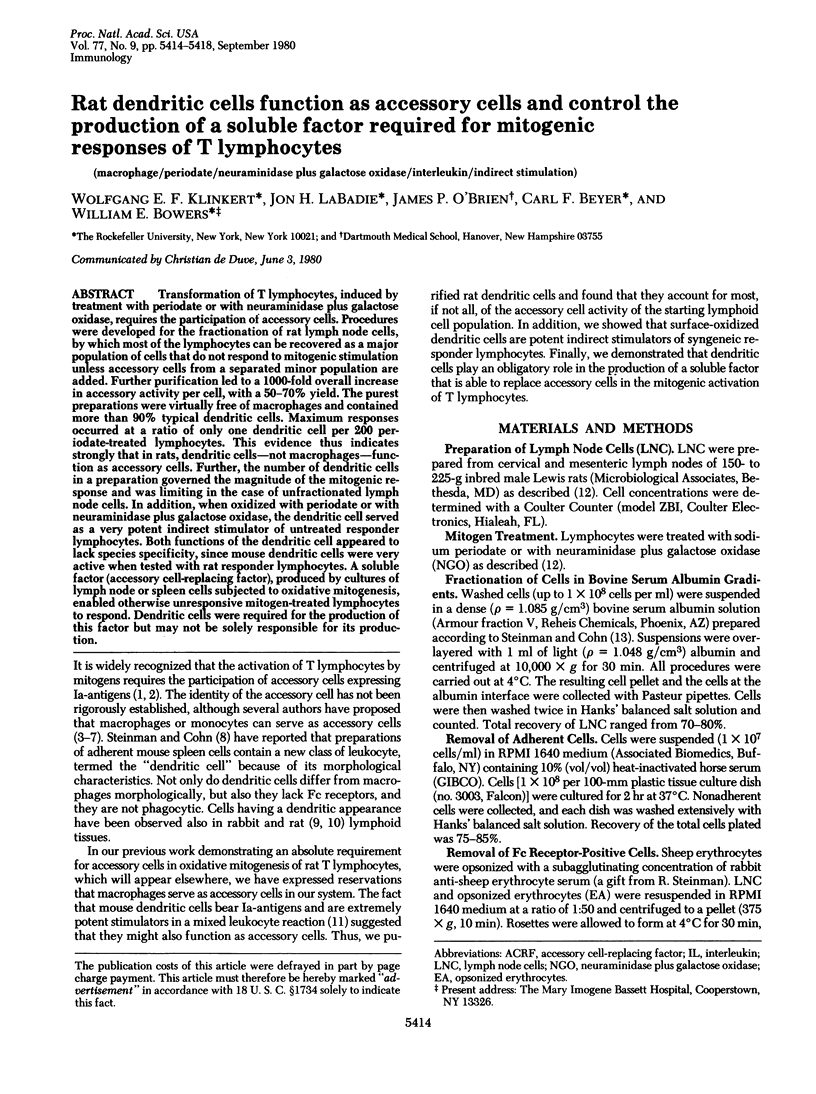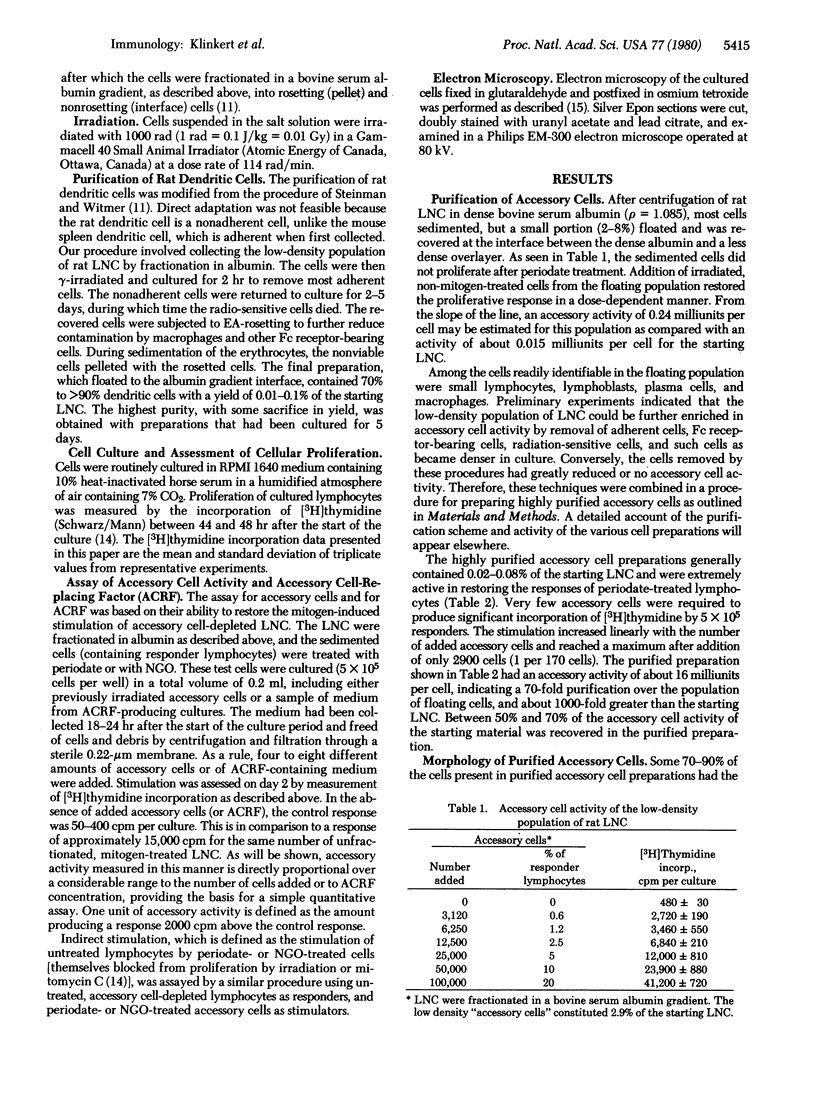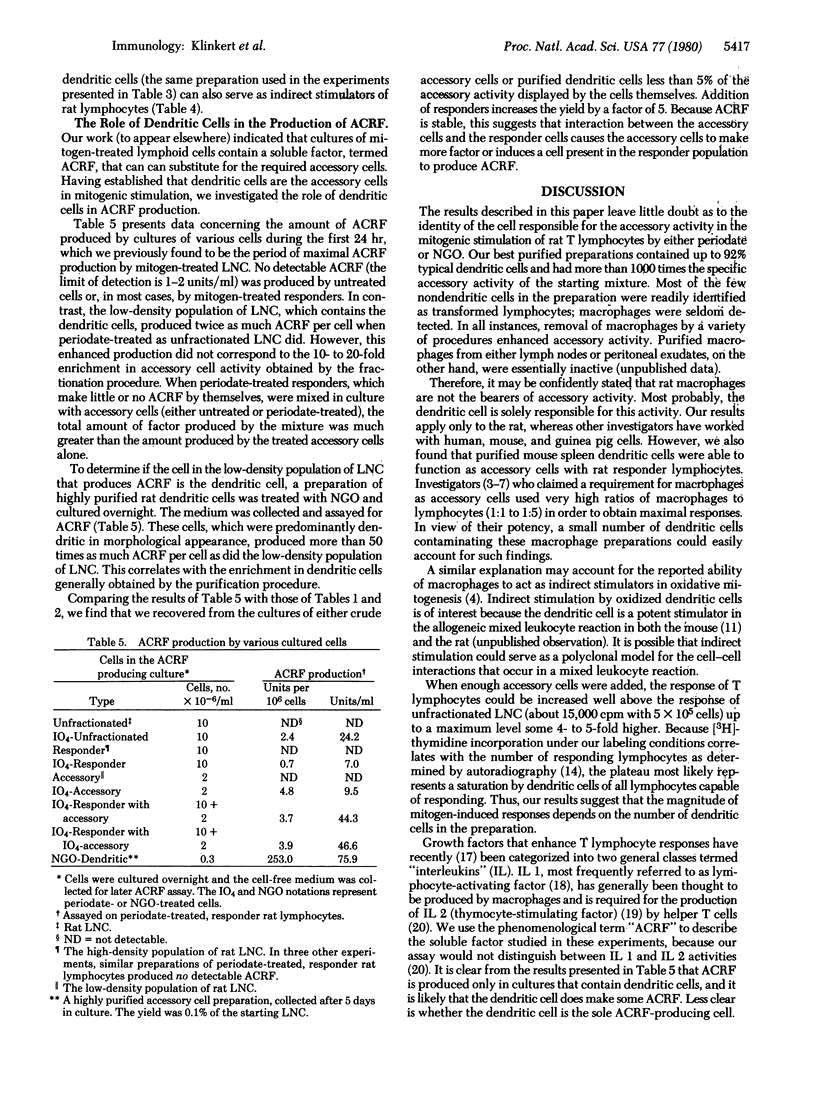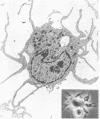Abstract
Transformation of T lymphocytes, induced by treatment with periodate or with neuraminidase plus galactose oxidase, requires the participation of accessory cells. Procedures were developed for the fractionation of rat lymph node cells, by which most of the lymphocytes can be recovered as a major population of cells that do not respond to mitogenic stimulation unless accessory cells from a separated minor population are added. Further purification led to a 1000-fold overall increase in accessory activity per cell, with a 50-70% yield. The purest preparations were virtually free of macrophages and contained more than 90% typical dendritic cells. Maximum responses occurred at a ratio of only one dendritic cell per 200 periodate-treated lymphocytes. This evidence thus indicates strongly that in rats, dendritic cells--not macrophages--function as accessory cells. Further, the number of dendritic cells in a preparation governed the magnitude of the mitogenic response and was limiting in the case of unfractionated lymph node cells. In addition, when oxidized with periodate or with neuraminidase plus galactose oxidase, the dendritic cell served as a very potent indirect stimulator of untreated responder lymphocytes. Both functions of the dendritic cell appeared to lack species specificity, since mouse dendritic cells were very active when tested with rat responder lymphocytes. A soluble factor (accessory cell-replacing factor), produced by cultures of lymph node or spleen cells subjected to oxidative mitogenesis, enabled otherwise unresponsive mitogen-treated lymphocytes to respond. Dendritic cells were required for the production of this factor but may not be solely responsible for its production.
Full text
PDF




Images in this article
Selected References
These references are in PubMed. This may not be the complete list of references from this article.
- Beyer C. F., Bowers W. E. Lymphocyte transformation induced by chemical modification of membrane components. I. Characteristics of the direct and indirect restimulation responses of rat lymph node cells to periodate. J Immunol. 1977 Dec;119(6):2120–2128. [PubMed] [Google Scholar]
- Beyer C. F., Bowers W. E. Lymphocyte transformation induced by chemical modification of membrane components. II. Effect of neuraminidase treatment of responder cells on proliferation and cytotoxicity in indirect stimulation. J Immunol. 1978 Nov;121(5):1790–1798. [PubMed] [Google Scholar]
- Beyer C. F., Bowers W. E. Periodate and concanavalin A induce blast transformation of rat lymphocytes by an indirect mechanism. Proc Natl Acad Sci U S A. 1975 Sep;72(9):3590–3593. doi: 10.1073/pnas.72.9.3590. [DOI] [PMC free article] [PubMed] [Google Scholar]
- Biniaminov M., Ramot B., Novogrodsky A. Effect of macrophages on periodate-induced transformation of normal and chronic lymphatic leukaemia lymphocytes. Clin Exp Immunol. 1974 Feb;16(2):235–242. [PMC free article] [PubMed] [Google Scholar]
- Chen D. M., Di Sabato G. Further studies on the thymocyte stimulating factor. Cell Immunol. 1976 Mar 15;22(2):211–224. doi: 10.1016/0008-8749(76)90024-1. [DOI] [PubMed] [Google Scholar]
- Gery I., Gershon R. K., Waksman B. H. Potentiation of the T-lymphocyte response to mitogens. I. The responding cell. J Exp Med. 1972 Jul 1;136(1):128–142. doi: 10.1084/jem.136.1.128. [DOI] [PMC free article] [PubMed] [Google Scholar]
- Gorenberg D. J., Daniele R. P. The alveolar macrophage: its capacity to act as an accessory cell in mitogen-stimulated proliferation of guinea pig lymphocytes. Cell Immunol. 1978 Mar 1;36(1):115–127. doi: 10.1016/0008-8749(78)90255-1. [DOI] [PubMed] [Google Scholar]
- Greineder D. K., Rosenthal A. S. The requirement for macrophage-lymphocyte interaction in T lymphocyte proliferation induced by generation of aldehydes on cell membranes. J Immunol. 1975 Oct;115(4):932–938. [PubMed] [Google Scholar]
- Haley N. J., Shio H., Fowler S. Characterization of lipid-laden aortic cells from cholesterol-fed rabbits. I. Resolution of aortic cell populations by metrizamide density gradient centrifugation. Lab Invest. 1977 Sep;37(3):287–296. [PubMed] [Google Scholar]
- Larsson E. L., Iscove N. N., Coutinho A. Two distinct factors are required for induction of T-cell growth. Nature. 1980 Feb 14;283(5748):664–666. doi: 10.1038/283664a0. [DOI] [PubMed] [Google Scholar]
- Mizel S. B., Farrar J. J. Revised nomenclature for antigen-nonspecific T-cell proliferation and helper factors. Cell Immunol. 1979 Dec;48(2):433–436. doi: 10.1016/0008-8749(79)90139-4. [DOI] [PubMed] [Google Scholar]
- Persson U., Hammarström L., Möller E., Möller G., Smith C. I. The role of adherent cells in B and T lymphocyte activation. Immunol Rev. 1978;40:78–101. doi: 10.1111/j.1600-065x.1978.tb00402.x. [DOI] [PubMed] [Google Scholar]
- Rosenstreich D. L., Farrar J. J., Dougherty S. Absolute macrophage dependency of T lymphocyte activation by mitogens. J Immunol. 1976 Jan;116(1):131–139. [PubMed] [Google Scholar]
- Rosenstreich D. L., Mizel S. B. The participation of macrophages and macrophage cell lines in the activation of T lymphocytes by mitogens. Immunol Rev. 1978;40:102–135. doi: 10.1111/j.1600-065x.1978.tb00403.x. [DOI] [PubMed] [Google Scholar]
- Schmidtke J. R., Hatfield S. Activation of purified human thymus-derived (T) cells by mitogens. II. Monocyte- macrophage potentiation of mitogen-induced DNA synthesis. J Immunol. 1976 Feb;116(2):357–362. [PubMed] [Google Scholar]
- Steinman R. M., Cohn Z. A. Identification of a novel cell type in peripheral lymphoid organs of mice. II. Functional properties in vitro. J Exp Med. 1974 Feb 1;139(2):380–397. doi: 10.1084/jem.139.2.380. [DOI] [PMC free article] [PubMed] [Google Scholar]
- Steinman R. M., Witmer M. D. Lymphoid dendritic cells are potent stimulators of the primary mixed leukocyte reaction in mice. Proc Natl Acad Sci U S A. 1978 Oct;75(10):5132–5136. doi: 10.1073/pnas.75.10.5132. [DOI] [PMC free article] [PubMed] [Google Scholar]
- Veerman A. J. On the interdigitating cells in the thymus-dependent area of the rat spleen: a relation between the mononuclear phagocyte system and T-lymphocytes. Cell Tissue Res. 1974 Apr 11;148(2):247–257. doi: 10.1007/BF00224586. [DOI] [PubMed] [Google Scholar]



